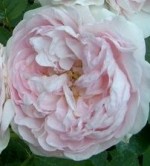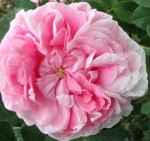
Albas have some outstanding characteristics like strong fragrance and moderate shade tolerance but unfortunately only bloom once in the spring or early summer. Their foliage is gray-green or blue-green and some cultivars produce attractive hips.
Flower Size: 2-4”
Petal Number: 5-200 depending on the cultivar
Flower Form: Flat, may be quartered, with central button
Flower Substance: Moderate
Flowering: Once in spring or early summer
Fragrance: Moderate to strong with overtones of citrus
Stem: Flowers borne in clusters
Size of Bush: Upright; 4-8’
Disease Resistance: Moderate to good; some susceptible to mildew and rust
Hardiness: Zone 4
Here are three albas that have excellent American Rose Society ratings and are most likely to be found for sale:

 ‘Celestial’ (also known as ‘Celeste) has soft pink flowers with a sweet frabgrance and grows to 6’ tall. ‘Celestial’ is considered one of the best albas.
‘Celestial’ (also known as ‘Celeste) has soft pink flowers with a sweet frabgrance and grows to 6’ tall. ‘Celestial’ is considered one of the best albas.
 ‘Great Maiden’s Blush’ grows to 5’ and has frgrant white flowers tinged with pink.
‘Great Maiden’s Blush’ grows to 5’ and has frgrant white flowers tinged with pink.
 The flowers of ‘Konigin von Danemark’ are flesh pink with darker centers have a strong fragrance, and are borne on a 7’ spreading bush.
The flowers of ‘Konigin von Danemark’ are flesh pink with darker centers have a strong fragrance, and are borne on a 7’ spreading bush.
